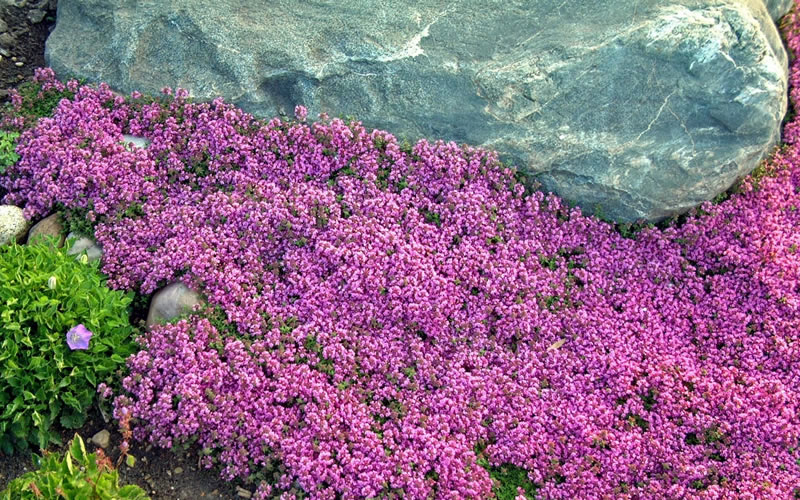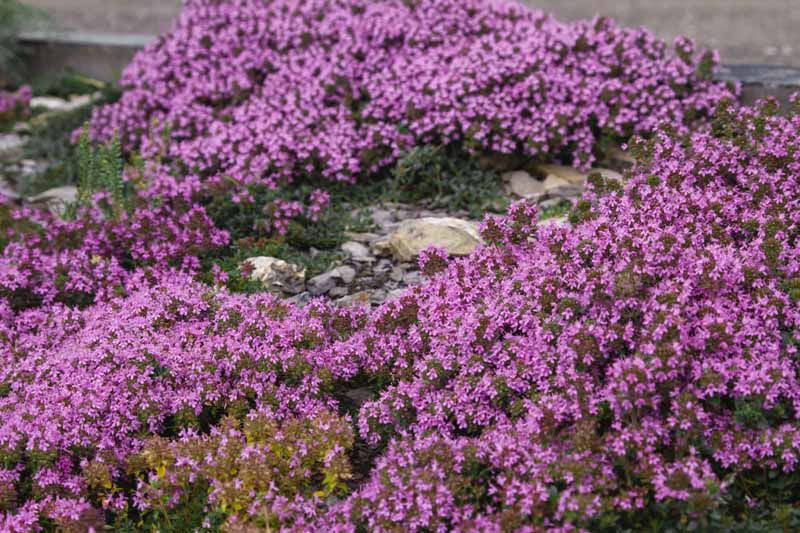Reddish-hued creeping thyme, with its vibrant tubular flowers in shades of deep pink and red, adds a splash of color to any garden. This herbaceous ground cover shrub forms a dense mat and requires minimal care. Its horizontally spreading stems take root in the soil, adorned with lush dark green leaves and charming dark pink-red flowers that release a delightful herby scent.
The uses of red creeping thyme in landscaping are numerous. Besides being an excellent ground cover for sunny areas, it can be planted as a border or edging plant, bringing texture and color to foundation plantings. It also works well in containers or hanging baskets, trailing gracefully with its aromatic stems.
This comprehensive guide provides identification and growing tips for the popular red creeping thyme shrub. Alongside vivid pictures and descriptions of this red-flowering ground cover plant, you will discover useful advice on propagating, planting, and nurturing red creeping thyme in your garden.
Introducing Red Creeping Thyme (Thymus praecox ‘Coccineus’)

Red creeping thyme, scientifically known as Thymus praecox ‘Coccineus,’ is a perennial herbaceous plant characterized by its small dark-pink to magenta-red flowers, aromatic dark-green leaves, and woody stems. Often referred to as “mother of thyme,” this low-growing shrub reaches a height of 3 inches (7.5 cm) and spreads up to 12 inches (30 cm). It thrives in full sun, tolerates drought and poor soils, making it a hardy and resilient choice for gardens.
Belonging to the Thymus genus and the mint family Lamiaceae, red creeping thyme is a cultivar of low-growing plants and small shrubs. It is also commonly known as wild thyme. It should not be confused with the similar creeping thyme species, Thymus serpyllum.
Red creeping thyme is classified as an herbaceous evergreen perennial shrub. In regions with mild winters, it retains its foliage throughout the year. However, in colder climates, it acts as a perennial, dying back in winter and reemerging in early spring. As a semi-evergreen ground cover plant, it tends to retain most of its leaves during cold weather.
Caring for Red Creeping Thyme
Red creeping thyme is a low-maintenance plant that thrives in full sun and well-draining soil. It is relatively drought-tolerant, requiring watering every 10 to 14 days in summer and more frequently during hot, sunny periods. Fertilization is not necessary.
Red Creeping Thyme’s Blossoming Beauty

The flowers of red creeping thyme are tubular or bell-shaped, displaying a captivating deep pink-magenta color. They bloom from June to September, creating a mesmerizing carpet of reddish-pink hues in gardens. Additionally, these nectar-rich flowers attract pollinators such as bees and butterflies.
Leaves and Aroma of Red Creeping Thyme
The foliage of red creeping thyme consists of ovate, dark-green leaves that emit a pleasant oregano-like fragrance when crushed. These small, aromatic leaves densely cover the woody stems, which can grow up to 12 inches (30 cm) in length.
Red Creeping Thyme Enhancing Landscapes
The low-growing nature of red creeping thyme makes it an ideal choice for summer-flowering ground cover. Its spreading stems form a lush cushion adorned with deep pink-red flowers and dark-green foliage, perfect for borders, edging, or adding a touch of color to front-of-house plantings.
This versatile shrub thrives in various garden settings. It can withstand foot traffic, making it suitable for filling gaps between stepping stones or flourishing in rock gardens, where it cascades over rocks, suppressing weed growth.
For those seeking vibrant magenta-reddish hues in their patio or container garden, red creeping thyme is an excellent option. Its cascading growth is a sight to behold, whether it spills over the edges of pots, hanging baskets, or retaining walls.
If you’re searching for a resilient ground cover plant for a deer-resistant garden, look no further than red creeping thyme (Thymus praecox).
Red Creeping Thyme’s Winter Charm
One of the appealing features of red creeping thyme in winter is its semi-evergreen foliage. In regions with mild winters, the shrub retains its dark green color throughout the year. In colder climates, it may experience some dieback, but it typically retains most of its leaves.
Protecting Red Creeping Thyme From the Cold
To safeguard red creeping thyme from freezing temperatures in harsh winters, it’s advisable to cover it with gravel or sand and ensure proper drainage.
Red Creeping Thyme as a Lawn Alternative
Red creeping thyme’s mat-forming growth habit makes it an excellent substitute for traditional lawns. It thrives in drought conditions, tolerates light foot traffic, requires minimal watering, and can withstand USDA zone 4.
In addition to these benefits, red creeping thyme provides the added allure of dark pink flowers in spring and fragrant aromas year-round. If you don’t wish to replace your entire lawn, you can plant it between paving stones or around patio pavers to fill gaps.
Identifying Red Creeping Thyme
Red creeping thyme is recognizable by its magenta-red tubular flowers, dark green foliage, woody stems, and prostrate growth reaching up to 3 inches (7.5 cm) tall. The ‘Coccineus’ cultivar showcases tiny, deep pink-red flowers that bloom throughout summer. Its aromatic, ovate dark-green leaves densely cover the fragrant, horizontally spreading stems.
Choosing the Right Spot for Red Creeping Thyme
For optimal growth, plant Thymus praecox ‘Coccineus’ in areas of your garden that receive full sun or dappled sunlight. Although red creeping thyme tolerates some shade, it may become leggy and bloom less abundantly. Therefore, select a location that provides at least six hours of sunlight daily.
Red creeping thyme is well-suited to sandy, rocky, and well-drained soils. It requires minimal care and can endure drought, although regular watering during hot spells is preferable.
This vibrant ground cover shrub thrives in temperate climates and is suitable for USDA zones 5 to 9. In colder regions (zone 4), providing additional winter protection is recommended.
Propagating Red Creeping Thyme
You can easily propagate red creeping thyme (Thymus praecox ‘Coccineus’) through division or stem cuttings. This low-growing shrub spreads by rooting its stems in the ground, allowing you to dig up small clumps and relocate them.
Here are some methods for propagating red creeping thyme:
Growing from Seeds: While growing red creeping thyme from seeds is possible, it can be challenging. The seeds are notorious for their low germination rates. To give them the best chance of sprouting, sow them in a moist seed-sowing compost or peat moss, covering the surface with additional peat moss. Enclose the container in plastic wrap to retain moisture and place it in a warm location. After approximately three weeks, the thyme seeds should germinate. Transplant the seedlings outdoors when they reach about 4 inches (10 cm) in height, watering regularly for the first few months to promote root establishment.
Planting Seedlings: The easiest way to grow red creeping thyme is to purchase nursery seedlings. Plant them directly in the ground in early spring, spacing them 8 to 12 inches (20 – 30 cm) apart. Provide regular watering for the first few weeks, transitioning to less frequent watering in subsequent years.
Division: If you already have red creeping thyme growing in your garden or know someone who does, you can propagate it through division. Select a healthy plant and dig up a large portion, ensuring the root system remains intact. Shake off excess soil and separate the plant into multiple sections, making sure each division has enough roots and woody stems to thrive. Plant the divided sections in the ground or individual planters, watering thoroughly. Maintain a regular watering schedule for two to three months to aid in establishment.
Caring for Red Creeping Thyme: Top Tips
Growing red creeping thyme outdoors requires ample sunlight, well-draining soil, and regular but not excessive watering. Consider the following care tips:
Watering: Generally, water red creeping thyme once or twice a month, depending on rainfall. During scorching summer days, daily watering may be necessary to prevent soil from drying out completely. As a rule of thumb, water when the top 2 to 3 inches (5 – 7.5 cm) of soil is dry. Young plants require more frequent watering.
Temperature and Humidity: Red creeping thyme is ideally suited for USDA zones 5 to 9. However, it may struggle in high humidity. Pruning the foliage annually and creating a layer of gravel or sand around the base can enhance air circulation and reduce moisture levels.
Fertilization: Red creeping thyme generally doesn’t require fertilizer. However, it thrives in moderately fertile, well-drained soil. If the plant exhibits slow growth or sparse foliage, you can apply a slow-release fertilizer in early spring to boost soil nutrients.
Pruning: Regular pruning, performed three times a year, encourages bushy growth, controls spreading, and eliminates leggy stems. In early spring, prune back the woody stems to stimulate vigorous growth. After flowering, trim the stems again. Finally, remove any leggy growth in late fall or early winter after the first frost.
Potting: Red creeping thyme’s trailing stems and vibrant flowers make it an ideal choice for containers, window boxes, or hanging baskets. Use well-draining potting soil amended with perlite to improve drainage. Ensure the container has sufficient drainage holes at the bottom. When the plant outgrows its pot, repot it using fresh potting mix, choosing a slightly larger container.
Common Problems and Solutions
Here are some common issues that may arise when growing red creeping thyme, along with potential solutions:
Pests: Hot and dry weather can attract spider mites to red creeping thyme. To combat these pests, spray the shrubs with water to dislodge them and ensure the soil remains adequately watered to prevent further problems.
Yellowing Leaves: Yellowing leaves are often a sign of overwatering and saturated soil. Improve drainage and reduce watering frequency. Infected plants with root rot may need to be removed.
Brown Leaves: Brown leaves can result from insufficient water, severe frost, or fungal diseases like root rot. Identify the cause and take appropriate action.
Woody Stems: Late-season leggy growth and sparse foliage can occur if red creeping thyme is grown in excessive shade. Prune the plants back at the end of each season to address this issue.
Lifespan: Red creeping thyme typically thrives for four to five years. After this period, the plant may dry out and turn brown, necessitating the planting of new specimens.
By following these guidelines and caring for red creeping thyme appropriately, you can enjoy the beauty of this vibrant ground cover in your garden landscape.